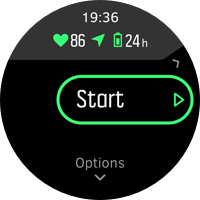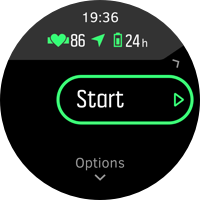Contents:
Getting to know the technology
Tips & tricks, dos & don'ts
Troubleshooting
Getting to know the technology
Wrist or optical heart rate technology, commonly known as WHR and OHR in the community, measures heart rate via your device's LEDs that track blood flow in your wrist. This results in you being able to see your heart rate data during your exercise or daily use without using a chest heart rate strap. Many manufacturers provide this technology in many formats and at different developmental stages. We offer WHR in the following watch models, from newer to older: Suunto 9 Peak, Suunto 9 Baro, Suunto 9, Suunto 7, Suunto 5, Suunto 3, Suunto 3 Fitness, and in the Suunto Spartan collection, which was our very first collection of wrist heart rate devices.
The accuracy of the optical heart rate measurement is influenced by many factors and can be affected by many individual differences. In case the data collected doesn't reflect the reality of your training, or you feel a chest sensor would be more appropriate for your type of activity, we recommend using a compatible chest heart rate sensor for more accurate readings. It can be any Bluetooth-compatible heart rate strap.
How optical heart rate measurement works
Optical heart rate devices use light to measure the amount of blood circulating through your veins and tissues. According to the volume of blood pumped, heart rate is either high or low based on the amount of light returning to the device: the more light, the lower the heart rate and vice-versa. In other words, the light entering your body around the wrist will scatter in a predictable manner when the blood flow dynamics change, such as with changes in blood pulse rate and with changes in blood volume, also known as the cardiac output.
Good to know about wrist heart rate measurement
It is an easy and convenient way to track your heart rate. However, it's good to keep in mind that the accuracy and reliability of optical heart rate measurement can vary from device to device and from person to person and may not work at all with certain types of activities or sports. Currently, the best wrist heart rate measurements stay 90% of the time within 5% of the chest-measured heart rate. Nevertheless, heart rate readings, optical or otherwise, are estimates and should be used only for reference and recreational use. They are not intended for medical use of any kind.
Together with our partners LifeQ and Valencell, we have identified the following factors that may affect heart rate measurement:
- When exercising in cool or cold temperatures, your body will try to keep your body temperature stable by directing the blood flow from your arms and legs towards the core. This reduction in blood flow to the arms can make it more difficult for the sensor to measure heart rate accurately.
- If you frequently have cold hands, a proper warmup before exercising is recommended to improve the accuracy of heart rate readings.
- Arm movements and flexing muscles, such as gripping a tennis racket or doing a Crossfit high-intensity training, or sports involving strong vibration as e.g. when cycling on uneven, bumpy terrain, may influence and change the accuracy of the sensor readings.
- The heart rate sensor may not provide accurate heart rate readings for swimming activities because of the water passing under the watch and affecting the optical sensor's ability to read heart rate accurately.
- Perspiration, darker skin tones and complexions, tattoos and body fat may reduce the accuracy of the readings of the optical sensor by adding extra informational layers between the device and the vessels such as a moisture layer (same effect as in swimming), more melanin or increased distance or artificial pigmentation.
Tips & tricks, dos & don'ts
How to wear your Suunto wrist heart rate monitor watch - a better fit for better readings
One of the previously mentioned factors with the biggest impact is how and where you wear your wrist heart rate tracker.
The right fit can help improve the accuracy of your heart rate readings. Start with the following tips, and then test and improve the fit of your watch until you find your personal sweet spot.
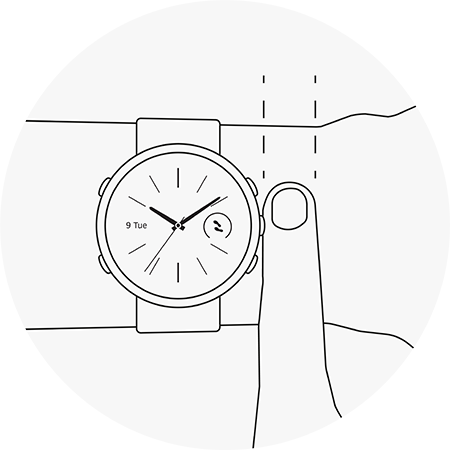 |
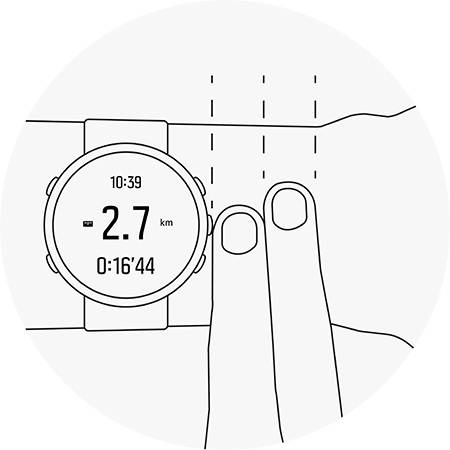 |
|
During daily use Wear your Suunto watch at least one finger above your wrist bone and make sure the watch is snug on your wrist. Your watch should always maintain contact with your skin so that you can't see the light shining from the sensor. |
During exercise Test the fit – the key is to wear the watch as high up on your wrist as possible and to prevent it from sliding down during exercise. A good indicator is to wear it about two fingers above your wrist bone. Again, make sure you wear the watch tight and evenly against the skin, however not too tight to cut off blood circulation. |
It takes time and practice to figure out the best fit for your wrist with a specific watch model. Try several and compare the results.
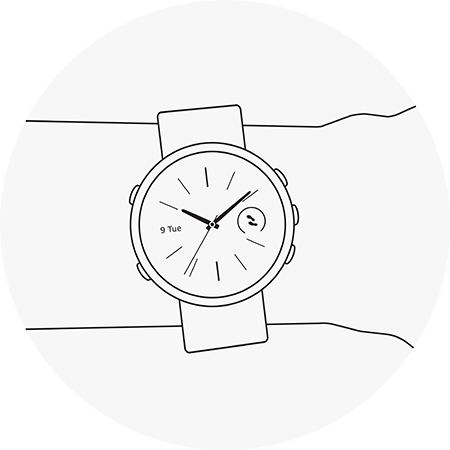 |
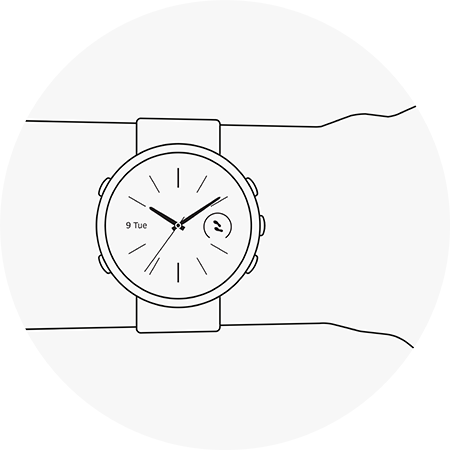 |
|
Too loose |
Just right It takes time and practice to figure out the best fit for your wrist with a specific watch model. Try several fits during sport and while resting and compare the results. Happy training!
|
For the best results, the following indications should help:
- Warm up before starting your training to get your blood pumping and your heart rate up. This will help your watch provide stable readings from the start.
- In case your watch loses the heart rate readings during your exercise, pause for a moment (approx. 10 – 30 seconds) and continue after your watch has started reading your heart rate again.
Things you should try to avoid:
- Wearing the watch too loose.
Make sure the sensor is always in direct contact with your skin. You shouldn't be able to see the light coming from the sensor. - Wearing the watch too tight.
Wearing the watch extremely tight can cut off blood flow and reduces the sensor's ability to monitor heart rate.
How to keep your skin happy:
- Regularly take the watch off your wrist, wash it and the strap with mild hand soap and water, rinse thoroughly and dry it well with a towel before putting it back on.
- Wash the watch body and the strap after every heavy workout.
- To remove the build-up of lotions and oils (such as sunscreen, insect repellent and moisturizers) trapped beneath the strap. Use mild hand soap, rinse thoroughly and dry well with a towel.
- Wearing your watch long-term on the same wrist may irritate your skin. Let your skin rest on a regular basis, by taking your watch off or switching the watch to the other wrist.
- Allergenic substances like fruit juice, raw potato, celery, albumen, corn, beans, peas, seafood, nuts, soy, wool, etc., and abrasive substances like dust, sand and some skin lotions trapped under the strap may cause severe skin irritation. Please refer to your GP if any of the allergic symptoms don't go away. Here you find some more information on how to care for your skin and Suunto watch.
Troubleshooting:
Keep your watch updated with the latest software version
One of the most important ways to get the best wrist heart rate performance is by making sure your watch has the latest software. We continuously improve the software of our products, deliver performance enhancements, and fix bugs and issues. Learn more about the software updates for your product and how to update your watch. Click here to learn about updating your Suunto 9 Peak.
No wrist heart rate information is recorded
In daily use:
If your wrist heart rate sensor fails and does not detect or read your heart rate, and if the heart rate sensor lights at the back of the watch are not blinking (wrist heart rate sensor seems to be not working/turned off), check if the Daily HR option is activated. Go to Settings - Activity and Daily HR and make sure the toggle is green. This will turn on continuous heart rate tracking in daily use. For Suunto 7, check the following video.
During exercise:
Make sure your watch is set to read the heart rate information from the wrist heart rate sensor and not from an HR belt, in case you have previously paired and used one (except Suunto 7). Go to Settings - Connectivity and Paired devices. In case an HR sensor is listed, you can either remove it, train with an HR belt, or switch to wrist heart rate by removing the connection.
If the above doesn't solve the issue, you could reset your watch. Here you have more information about resetting Suunto devices.
Too high or low heart rate readings after you started an exercise
We recommend a warm-up before you start your exercise to increase heart rate and blood flow that will help stabilize the readings. The quality of wrist-based heart rate measurement depends on the blood flow to your arms and hands. A proper warm-up for 10-15 minutes increases the blood flow and improves the quality of wrist heart rate readings.
You can either record the warm-up and not take into account the heart rate data inconsistencies or start preparing for your main sport by activating the Start screen and doing your warm-up while the watch locks in the GPS and heart rate.
More accurate readings with a chest heart rate sensor
Because of the technology employed, heart rate belts will offer more accurate readings than wrist-based devices. We encourage the usage of a compatible chest heart rate sensor whenever the situation calls for one. It will enable you to get heart rate readings even when mounting the watch on the handlebar of a bike or whilst wearing it on top of your sleeve.
When you have a heart rate belt paired with your watch, the heart rate icon on the exercise start screen will show a small belt around the heart.
|
|
|

